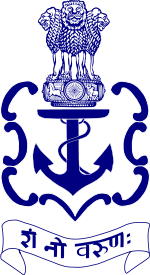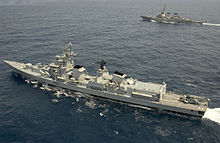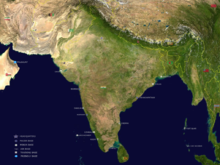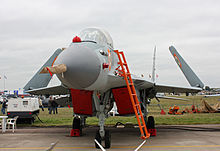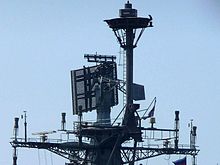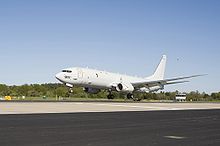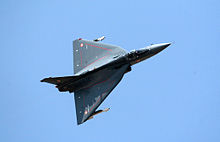- Indian Navy
-
Indian Navy
Indian Navy crestActive 1947–Present Country  India
IndiaBranch Navy Size 55,000 personnel
175+ Ships
250+ aircraftPart of Ministry of Defence
Indian Armed ForcesHeadquarters New Delhi Motto शं नो वरुणः Transliteration: Sham No Varunah (May the Lord of the Oceans be auspicious unto us)
Colors Navy Blue, White Anniversaries Navy Day: 4th December Engagements Portuguese-Indian War
Indo-Pakistani War of 1965
Bangladesh Liberation War
Indo-Pakistani War of 1971Decorations Indian Military Honour Awards Commanders Chief of Naval Staff Admiral Nirmal Kumar Verma Notable
commandersAdmiral S. M. Nanda Insignia Indian Navy Ensign 
Aircraft flown Attack BAE Sea Harrier Electronic
warfareDornier Do 228 Fighter BAE Sea Harrier, Mikoyan MiG-29K Helicopter HAL Dhruv, Kamov Ka-28, Kamov Ka-31, Sea King Mk.42C, UH-3 Sea King Patrol Ilyushin Il-38, Tupolev Tu-142 Reconnaissance Dornier Do 228, IAI Heron, IAI Searcher Mk II Trainer HAL HJT-16, Harrier T-60 The Indian Navy (Devanāgarī: भारतीय नौ सेना, Bhāratīya Nau Senā) is the naval branch of the armed forces of India. The President of India serves as the Commander-in-Chief of the Navy. The Chief of Naval Staff (CNS), usually a four-star officer in the rank of Admiral, commands the Navy. As of 2006 the navy has 55,000[1] personnel on active duty, including 5,000 members of the naval aviation branch, 1,200 marine commandos[2] and 1,000 Sagar Prahari Bal soldiers,[3] making it the world's fourth largest navy.[4][2] The Indian Navy currently has around 170 major vessels in commission, including the aircraft carrier INS Viraat, along with operational jet fighters.[5]
Though the primary objective of the navy is to secure national maritime borders, India also uses its navy to enhance its international relations through joint exercises, port visits and humanitarian missions, including disaster relief. In recent years, the Indian Navy has undergone extensive modernisation and expansion as part of its aim to transition to a blue water navy.[6][7][8][9]
Contents
Role
The Indian Navy sees several principal roles for itself:
- In conjunction with other armed forces of the union, act to deter or defeat any threats or aggression against the territory, people or maritime interests of India, both in war and peace;
- Project influence in India's maritime area of interest, to further the nation’s political, economic and security objectives;
- In cooperation with the Indian Coast Guard, ensure good order and stability in India's maritime zones of responsibility.
- Provide maritime assistance (including disaster relief) in India's maritime neighbourhood.[10]
- To play a key role as part of 'a pluralistic security order' for a better world.[11]
History
Main article: History of the Indian NavyEarly maritime history
Main article: Indian maritime historyIndia has a maritime history dating back to 7,600 years.[12][13][14][15] The first tidal dock is estimated to have been built at Lothal around 2300 BCE during the Indus Valley Civilization, near the present day Mangrol harbour on the Gujarat coast.[16][17] The Rig Veda written around 1500 BCE, credits Varuna with knowledge of the ocean routes and describes naval expeditions. There is reference to the side wings of a vessel called Plava, which give stability to the ship under storm conditions. A compass, Matsya yantra, was used for navigation in the fourth and fifth century AD.
The earliest known reference to an organisation devoted to ships in ancient India is to the Mauryan Empire from the 4th century BCE. Emperor Chandragupta Maurya's Prime Minister Kautilya's Arthashastra devotes a full chapter on the state department of waterways under navadhyaksha (Sanskrit for Superintendent of ships) [3]. The term, nava dvipantaragamanam (Sanskrit for sailing to other lands by ships, i.e. Exploration) appears in this book in addition to appearing in the Buddhist text, Baudhayana Dharmasastra as the interpretation of the term, Samudrasamyanam.
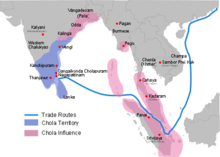 Chola territories during Rajendra Chola I, c. 1030
Chola territories during Rajendra Chola I, c. 1030
Sea lanes between India and neighbouring lands were the usual form of trade for many centuries, and are responsible for the widespread influence of Indian Culture on other societies. Powerful navies included those of the Maurya, Satavahana, Gupta, Chola, Pandya, Vijayanagara, Kalinga, Mughal and Maratha empires.[18] The Cholas excelled in foreign trade and maritime activity, extending their influence overseas to China and Southeast Asia.
During the 17th and 18th centuries, the Maratha and Kerala fleets were expanded, and became the most powerful Naval Forces in the subcontinent, defeating European Navies at various times (See the Battle of Colachel). The fleet review of the Maratha navy took place at the Ratnagiri fort in which the ships Gurabs, Galbat, Pal & small ships called as "Sangmeshwari" participated. The 'Pal' was a three masted fighter with guns peeping on the broadsides.[19] Kanhoji Angre and Kunjali Marakkar, the Naval chief of Saamoothiri, were two notable naval chiefs of the period.
Origins
Main article: Royal Indian NavyIn 1612, the British East India Company established the Honourable East India Company's Marine to protect its merchant shipping off the Gulf of Cambay and up the Narmada and Tapti rivers. Its first fighting ships in India were acquired on 5 September 1612.
This force evolved into Her Majesty's Indian Navy in 1830, while most of India was under British rule. While the force at this time had British officers and Indian sailors. The Navy saw action in the First Opium War of 1840 and in the Second Anglo-Burmese War in 1852. During World War I, the force then known as the Royal Indian Marine undertook minesweeping, as well as supply and support operations for the Allies.
Early 20th century
Sub Lieutenant D. N. Mukherji was the first Indian to be granted a commission as an engineer officer in 1928. In 1934, the navy was renamed as the Royal Indian Navy (RIN).
The onset of World War II led to an expansion in numbers of vessels and personnel. The navy was actively involved in operations during the war around the world. Its sloops HMIS Sutlej and HMIS Jumna played a key role in Operation Husky, the Allied invasion of Sicily.[20] It was heavily involved in operations around the Indian Ocean, including convoy escorts, mine-sweeping, supply, as well as supporting amphibious assaults.
At the end of the war, the navy underwent rapid, large-scale demobilization of vessels and personnel. In 1946, Indian sailors started the Royal Indian Navy Mutiny, a rebellion on board ships and on shore establishments to protest discrimination against Indian officers and sailors by the British. A total of 78 ships, 20 shore establishments and 20,000 sailors were involved in the rebellion, which spread all over India.
After the independence of India on 15 August, 1947 and the ensuing partition, the RIN's depleted fleet of ships and remaining personnel were divided between the newly independent Union of India and Dominion of Pakistan.
When India became a republic on 26 January 1950, the Royal prefix was dropped and the name Indian Navy was officially adopted. The prefix on her ships was changed to Indian Naval Ship (INS).
Independence to the 1960s
Main article: 1961 Indian annexation of GoaDuring the early years following independence, the navy still had many British officers who continued to serve with the Indian Navy. Vice Admiral Ram Dass Katari was the first Indian to assume office as the Chief of Staff of the Indian Navy on 22 April 1958.
The first engagement in action of the Indian Navy was against the Portuguese Navy during the liberation of Goa in 1961. Operation Vijay followed years of escalating tension due to Portuguese refusal to relinquish its colonies in India. On 21 November 1961, Portuguese troops fired on the passenger liner Sabarmati near Anjadip Island, killing one person and injuring another. During Operation Vijay, the Indian Navy supported troop landings and provided fire support. INS Delhi (1948) sank one Portuguese patrol boat, while frigates Sino-Indian War was largely fought over the Himalayas and the Navy had only a defensive role in the war.
Indian Naval activity in the Indo-Pakistani War of 1965 largely involved coastal patrols. During the war, the Pakistani Navy attacked the Indian coastal city of Dwarka, although there were no military resources in the area. While this attack was insignificant,[22] India deployed naval resources to patrol the coast and deter further bombardment.
Following these wars in the 1960s, India resolve to strengthen the profile and capabilities of its Armed Forces.
Late 20th century
Main article: Indo-Pakistani wars and conflicts Aircraft carrier INS Vikrant (R11) played a crucial role in enforcing the naval blockade on East Pakistan and ensuring India's victory during the Indo-Pakistani War of 1971
Aircraft carrier INS Vikrant (R11) played a crucial role in enforcing the naval blockade on East Pakistan and ensuring India's victory during the Indo-Pakistani War of 1971
The dramatic change in the Indian Navy's capabilities and stance was emphatically demonstrated during the Indo-Pakistani War of 1971. Under the command of Admiral Sardarilal Mathradas Nanda, the navy successfully enforced a naval blockade of West and East Pakistan.[23][24]
Pakistan's lone long-range submarine PNS Ghazi was sunk following an attack by the destroyer INS Rajput (1942) off the coast of Visakhapatnam around midnight of 3-4 December 1971.[25][26][27][28][29] On 4 December, the Indian Navy successfully executed Operation Trident, a devastating attack on the Pakistan Naval Headquarters of Karachi that sank a minesweeper, a destroyer and an ammunition supply ship. The attack also irreperably damaged another destroyer and oil storage tanks at the Karachi port. This was followed by Operation Python on 8 December 1971, further deprecating the Pakistan Navy's capabilities. Indian frigate INS Khukri was sunk by the PNS Hangor (S131), while Bay of Bengal, INS Vikrant (R11) was deployed off the coast of East Pakistan to successfully prevent delivery of supplies to Pakistani military forces in the East. Sea Hawk and the Alizés aircraft from the aircraft carrier sank numerous gunboats and Pakistani merchant marine ships.[30] To demonstrate its solidarity as an ally of Pakistan, the United States of America sent Task Force 74 centered around the aircraft carrier USS Enterprise into the Bay of Bengal. In retaliation, Soviet Navy submarines trailed the American task force, which moved away from the Indian Ocean towards Southeast Asia to avert a confrontation.[31]
In the end, the Indian naval blockade of Pakistan choked off the supply of reinforcements to the Pakistani forces,[32] which proved to be decisive in the overwhelming defeat of Pakistan.[33][34]
Since playing a decisive role in the victory, the navy has been a deterrent force maintaining peace for India in a region of turmoil. In 1988, India launched Operation Cactus, to successfully thwart a coup d'état by PLOTE in the Maldives.[35] Naval maritime reconnaissance aircraft detected the ship hijacked by PLOTE rebels. INS Godavari (F20) and Indian marine commandos recaptured the ship and arrested the rebels.[36]
During the 1999 Kargil War, the Western and Eastern fleets were deployed in the Northern Arabian Sea, as a part of Operation Talwar.[37] They safeguarded India's maritime assets from a potential Pakistani naval attack, as also detered Pakistan from attempting to block India's sea-trade routes.[38] The Indian Navy's aviators flew sorties and marine commandos fought alongside Indian Army personnel in the Himalayas.[39][40]
21st century
In the 21st century, the Indian Navy has played a vital role in maintaining peace for India on the maritime front, in spite of the state of ferment in its neighborhood.[41] It has been deployed for humanitarian relief in times of natural disasters and crises across the globe, as well as to keep India's maritime trade routes free and open.
The Indian Navy was a part of the joint forces exercises, Operation Parakram, during the 2001–2002 India–Pakistan standoff. More than a dozen warships were deployed to the northern Arabian Sea.[42]
In 2001, the Indian Navy took over operations to secure the Strait of Malacca, to relieve US Navy resources for Operation Enduring Freedom.[43]
Humanitarian operations
 Indian Navy Surgeon listens to the heart of a patient during MEDCAP at Pohpein, Micronesia.
Indian Navy Surgeon listens to the heart of a patient during MEDCAP at Pohpein, Micronesia.
The navy has played a crucial role in providing humanitarian relief in times of natural disasters, including floods, cyclones and tsunamis.
In the aftermath of the 2004 Indian Ocean earthquake and tsunami, the Indian Navy launched massive disaster relief operations to help affected Indian states as well as Maldives, Sri Lanka and Indonesia. Over 27 ships, dozens of helicopters, at least 6 fixed-wing aircraft and over 5000 personnel of the navy were deployed in relief operations.[44] These included Operation Madad in Andhra Pradesh and Tamil Nadu, Operation Sea Waves in the Andaman and Nicobar Islands, Operation Castor in Maldives, Operation Rainbow in Sri Lanka and Operation Gambhir in Indonesia.[45] This was one of the largest and fastest force mobilisations that the Indian Navy has undertaken. Indian naval rescue vessels and teams reached neighboring countries less than 12 hours from the time that the tsunami hit.[44][46] Lessons from the response led to decision to enhance amphibious force capbilities, including the acquisition of Landing Platform Docks such as the INS Jalashwa (L41), as well as smaller amphibious vessels.[47][48]
During the 2006 Israel-Lebanon conflict, the Indian Navy launched Operation Sukoon to evacuate 2,286 Indian nationals and expatriates, besides 436 Sri Lankan and 69 Nepali citizens, from war-torn Lebanon.[49][50] In 2006, Indian naval doctors served for 102 days on board USNS Mercy to conduct about medical camps in Philippines, Bangladesh, Indonesia and East Timor.[51]
In 2007, Indian Navy supported relief operations for the survivors of Cyclone Sidr in Bangladesh.[52] In 2008, Indian Naval vessels were the first to launch international relief operations for victims of Cyclone Nargis in Myanmar.[53][54]
Anti-piracy operations
In October 1999, a coordinated effort by the Indian Navy and the Indian Coast Guard led to the rescue of pirated Japanese cargo ship, MV Alondra Rainbow.[55]
In 2008, the navy deployed INS Tabar (F44) and INS Mysore (D60) into the Gulf of Aden to combat piracy in Somalia.[56] Tabar prevented numerous piracy attempts,[57][58][59] and escorted hundreds of ships safely through the pirate-infested waters.[60][61][62] The navy also undertook anti-piracy patrols off Seychelles, upon that country's request.[63][64][65]
In 2011, the navy launched Operation Island Watch to deter piracy attempts by Somali pirates off the Lakshadweep archipelago. This operation has had numerous successes in preventing pirate attacks.[66][67][68][69][70]
Personnel
Commissioned officers
Rank Insignia Shoulder 













Sleeve 









Rank Admiral of
the Fleet[note 1]Admiral Vice Admiral Rear Admiral Commodore Captain Commander Lieutenant
CommanderLieutenant Sublieutenant The Commander of the Navy is the Chief of Naval Staff (CNS). Admiral Nirmal Kumar Verma, who was formerly the Eastern Naval Commander at Visakhapatnam, has assumed responsibility as the head of Navy from incumbent Admiral Sureesh Mehta, who retires from service.[71]
While the provision for the rank of Admiral of the Fleet exists, it is primarily intended for major wartime use and honour. No officer of the Indian Navy has yet been conferred this rank. (Both the Army and Air Force have had officers who have been conferred with the equivalent rank – Field Marshals Sam Manekshaw and Cariappa of the Army and Marshal of the Indian Air Force (MIAF) Arjan Singh.)
Enlisted personnel
Organisation
The Indian Navy is divided into the following broad categories:
- Administration
- Logistics and Material
- Training
- Fleets
- Naval Aviation
- Submarines
Commands
The Indian Navy operates three Commands. Each Command is headed by a Flag Officer Commanding-in-Chief in the rank of Vice Admiral.
Commands HQ Location Current FOC-in-C Western Naval Command Mumbai Vice Admiral D K Joshi Eastern Naval Command Visakhapatnam Vice Admiral Anoop Singh Southern Naval Command Kochi Vice Admiral K N Sushil Two of the three commands have a two-star commanded Fleet, the Eastern and Western Fleets, and each also has a Commodore Commanding Submarines. Southern Naval Command is home to Flag Officer Sea Training.
Additionally, the Andaman and Nicobar Command at Port Blair under Vice Admiral D K Joshi is a joint command reporting to the Chief of Integrated Service Command (CISC) in New Delhi. The Andaman and Nicobar Command, a joint Navy, Indian Army and Indian Air Force command was set up in the Andaman and Nicobar Islands in 2001.[72] It was created to safeguard India's strategic interests in Southeast Asia and the Strait of Malacca.[73]
The Indian Navy plays a major role in patrolling the area with the Indonesian Navy, Royal Malaysian Navy and Royal Thai Navy.[74][not in citation given] India and Australia signed an agreement to provide maritime security in the Asia Pacific region.[75]
Bases
 Indian Navy Tu-142 and IL-38SD stationed at Arakkonam Naval Air Station
Indian Navy Tu-142 and IL-38SD stationed at Arakkonam Naval Air Station
In 2005, the Indian Navy commissioned INS Kadamba at Karwar, 100 km from Goa. This is the third operational naval base after Mumbai and Vishakapatnam and the first to be controlled exclusively by the Navy. (The other bases share port facilities with civilian shipping, but this one is for purely naval use.) Built under Phase I of the multi-billion dollar Project Seabird, it is the largest naval base in the region.[76] Asia's largest Naval academy INS Zamorin, was inaugurated at Ezhimala, in January 2009 by the Prime Minister of India.[77]
Another naval base is being planned for the eastern shores, near Vishakapatnam at a cost of US$350 million.[78] The base, which will be located fifty km south of Vishakapatnam in Rambilli Mandal, will have comprehensive anti-aircraft, anti-submarine and amphibious capability.[79] This east coast base expansion program is in direct response to Chinese PLA Navy activities in the region.[80]
The Indian Navy is setting up a naval station in Madagascar,[81][82] to monitor and patrol the coast of Mozambique as well as the Southern Indian Ocean.[83]
The Indian Navy also has berthing rights in Oman and Vietnam.[84]
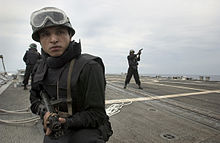 Indian Navy's marine commandos during an exercise in the Philippine Sea.
Indian Navy's marine commandos during an exercise in the Philippine Sea.
Marine Commando Force
The Marine Commando Force (MCF), also known as MARCOS, is a special forces unit that was raised by the Indian Navy in 1987 for direct action, special reconnaissance, amphibious warfare and counter-terrorism. In 1988, the MARCOS successfully rescued several hostages, including Maldives' then-Minister of Education, aboard a ship hijacked by PLOTE mercenaries during Operation Cactus. The MARCOS are also deployed to prevent infiltration through the Jhelum and Wular Lake and are involved in covert counter-terrorism operations in and around lakes and rivers in Jammu and Kashmir.[85][86]
The MARCOS were also involved in the rescue mission of hostages captured by the terrorists in Taj Mahal Palace & Tower luxury hotel in Mumbai as part of a large terrorist attack in Mumbai metropolis in November 2008.
Ships
Main article: Ships of the Indian NavyThe names of all commissioned ships (and Naval Bases) of the Indian Navy are prefixed with the letters INS, designating Indian Naval Ship or Indian Navy Station.
The fleet of the Indian Navy is a mix of domestic built and foreign vessels and is expanding rapidly with new inductions.
Destroyers
The Indian Navy currently operates the Delhi and Rajput class guided-missile destroyers.
The next-generation, Kolkata class vessels are expected to be commissioned starting in 2012.
 INS Shivalik the first indigenous stealth ship of the Indian navy.
INS Shivalik the first indigenous stealth ship of the Indian navy.
Frigates
The guided-missile frigates currently in service are the Shivalik class , Talwar class, Brahmaputra class and Godavari class. The Nilgiri class (variants of the British Leander class) vessels have all except 2 been decommissioned. The three Advanced Talwar class frigates (Krivak IV) are also scheduled for delivery by 2012.
Further vessels of the Shivalik class are undergoing sea trials and expected to be commissioned in 2011.
Corvettes
The Indian Navy currently operates the Kora, Khukri, Veer and Abhay class corvettes.
The next-generation Project 28 and Project 28A class of corvettes are expected to be commissioned starting in 2012.
Amphibious warfare vessels
The Indian Navy has an Amphibious transport dock of the Austin class, re-christened as INS Jalashwa in service. Besides, it also maintains a fleet of tank landing ships and other smaller vessels. It currently has no dedicated helicopter carrier in its possession which is a shortcoming as other navies in the world with aspiring blue water navy capabilities have them, the gap formed is hence filled by indian navy by operating the helicopters from its aircraft carrier to carry out amphibious operations along with anti submarine warfare roles.
Aircraft carriers
The Indian Navy presently has one aircraft carrier in active service — INS Viraat. The carrier is planned for decommissioning after the induction of the first domestically built Vikrant class aircraft carrier. The Indian Navy will also induct the Russian-built INS Vikramaditya in 2012.[87]
Submarines
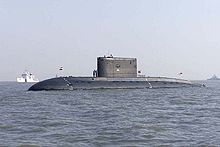 INS Sindhurakshak (S63), a Sindhughosh class submarine
INS Sindhurakshak (S63), a Sindhughosh class submarine Main article: List of submarines of the Indian Navy
Main article: List of submarines of the Indian NavyDiesel submarines
The Indian Navy operates a fleet of diesel-electric submarines of the Sindhughosh and Shishumar classes.
India has started construction of six Scorpène class submarines with MESMA air-independent propulsion. These submarines will join the Indian Navy from second half of 2015 onwards.[88] India issued a request for information for another six submarines in 2011.[89][90]
Nuclear powered submarines
In 1988, India acquired an ex-Soviet Charlie class nuclear powered guided missile submarine with eight Ametist (SS-N-7 Starbright) anti-shipping missile launchers on a 3-year lease. In the Indian Navy, the vessel was commissioned as INS Chakra, and the submarine was manned by an Indian crew. Upon expiration of the lease term in 1991, the submarine was returned to Russia and joined the Pacific Fleet of the Russian Navy.
 CGI of INSArihant, India's first ballistic missile nuclear submarine.
CGI of INSArihant, India's first ballistic missile nuclear submarine.
India paid US$2 billion for the completion of two Akula-II class submarines which were 40–60% completed.[91] Three hundred Indian Navy personnel were trained in Russia for the operation of these submarines. India has finalized a deal with Russia, in which at the end of the lease of these submarines, it has an option to buy them. The first submarine is named INS Chakra, was supposed to be handed over in August 2010, but delayed for unknown reasons until end of 2011.[92][93][94]
India's indigenously designed and built nuclear-powered ballistic missile submarines of the Arihant class are expected to be commissioned starting in 2012.[95] The lead vessel of the class, INS Arihant, was launched for sea-trials on 26 July 2009 in Visakhapatnam.[96] The Navy plans to have six SSBN's in service.[97]
Fleet tankers
The Indian Navy currently operates 3 replenishment tankers and one has been launched.They are the Jyoti Class Tanker , INS Aditya (A59) and the new Deepak class fleet tanker.The Deepak class tankers will be the mainstay till the 1st half of the 21st century. The 2nd of the Deepak class will be named 'Shakti'.
Planned acquisitions
The Navy is purchasing from Russia the Kiev class aircraft carrier Admiral Gorshkov (INS Vikramaditya), which will be delivered to India by 2012.[98]
The Indian Navy is also negotiating with Russia for the acquisition of further Advanced Talwar class frigates, and six conventional submarines.
India started a programme in 1985 to develop indigenous technologies for building a nuclear-powered submarine, known as the Advanced Technology Vessel (ATV) project .The first Advanced Technology Vessel is called INS Arihant, was launched on 26 July 2009.[99] The hull for the vessel has been built by Larsen & Toubro at its A naval version of a nuclear reactor has been developed at the Indira Gandhi Centre For Atomic Research, Kalpakkam and will be deployed on the submarine's hull after miniaturisation. The Prototype Testing Centre (PTC) will be used to test the submarine's turbines and propellers. A similar facility is operational at Vishakapatnam to test the main turbines and gear box.
Once the vessel is completed, it may be equipped with K-15 as well as Sagarika/Agni-III ballistic missiles and advanced Indian made sonar systems. According to defence sources, the ATV is expected to be commissioned in 2010. Each unit will cost US$1 billion.[100] Government has given approval for constructing the follow on SSBN's which will be larger than the Arihant class submarines. Approval has also been given for the construction of SSN's which will escort the SSBN's.[101]
Aircraft
Main article: Indian Naval Air ArmThe naval air-arm is an important component of the Indian Navy. The Indian Navy air arm consists of Sea Harrier jets that operate from the aircraft carrier INS Viraat and also from INS Jalashwa. The Kamov-31 provide the Airborne Early Warning cover for the fleet. In the anti-submarine role the Sea King, Ka-28 and the domestic built HAL Dhruv are used. The MARCOS use Sea King and HAL Dhruv helicopters while conducting operations. Reconnaissance operations are carried out by Tupolev 142, Ilyushin 38, Dornier Do 228 aircraft, as well as HAL Chetak helicopters. The Aircraft used for carrying out roles of a strategic bomber and as a maritime strike are carried out by 4(3 more on order) Tupolev Tu-22M, which is also capable of performing reconnaissance missions. The UAV arm consists of around 30 UAVs like Heron and Searcher-IIs that are operated from ships and shore for better surveillance. The Indian Navy also maintains a four aircraft aerobatic display team, the Sagar Pawan. The Sagar Pawan team will be replacing their present Kiran HJT-16 aircraft with the newly developed HJT-36 aircraft.[102] The Indian Navy has also placed an order for 8 P-8I Poseidon long-range maritime reconnaissance (LRMR) aircraft.,[103] with further orders for four more aircraft awaiting approval from the Government of India.[104]
In January 2004, the Indian Navy signed a contract for the delivery of 12 MiG-29K and 4 MiG-29KUB which will be operated from INS Vikramaditya.[105] The first MiG-29KUB manufactured for the Navy took to the skies in May 2008.[106] The first four aircraft were delivered to India in February 2009.[107] There were also reports that the Indian Navy would purchase an additional 30 MiG-29Ks and -KUBs for the Indigenous Aircraft Carrier.[108][109] The Indian Navy has a requirement of 50 Naval Tejas aircraft. The first prototype NP-1 is expected to fly in 2010.[110]
The Indian Air Force also has a maritime strike role, providing support to the Indian Navy. It operates SEPECAT Jaguar[111][112] and Sukhoi Su-30MKI[113] Aircraft in this role. The Jaguars are armed with the Sea Eagle missile, which will be replaced with the Harpoon missile.[114] Su-30MKI and the Il-38 will be armed with the air-launched version of the Brahmos cruise missile.
Weapon systems
Main article: Weapon systems of the Indian Navy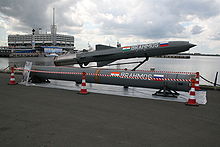 Brahmos supersonic cruise missile is becoming the primary anti-ship missile of the Indian Navy.
Brahmos supersonic cruise missile is becoming the primary anti-ship missile of the Indian Navy.
The Indian Navy uses modern technology and weapon systems, most of which are imported from foreign countries. Others, like the BrahMos supersonic cruise missiles, are jointly developed. There are reports on the joint development by India and Israel of the Barak-II missile system, an improved, longer range version of the Barak-I air defence missile which is operational on Indian Navy ships.[115] The Barak-I is used on most of the main ships of the Indian Navy. The Indian Navy's nuclear deterrence capability is based on Sukanya class ships armed with the Dhanush ballistic missiles that has a range of 350 km.
India has a number of foreign made cruise missile systems, including the Klub SS-N-27. It also has its own Nirbhay cruise missile systems under development. The Sagarika (Oceanic) submarine launched ballistic missile (SLBM), which has a range of at least 700 km (some sources claim 1000 km) forms part of India's nuclear triad. Another successful programme has been the adaptation of the Yakhont anti-ship missile system into the BrahMos by the NPO and the DRDO. The BrahMos has been tailored to Indian needs and uses a large proportion of Indian-designed components and technology, including its fire control systems, transporter erector launchers, and its onboard navigational attack systems. The successful test of Brahmos from INS Rajput (D51) provides Indian Navy with precision land attack capability.[116]
Electronic warfare and systems management
Sangraha is a joint electronic warfare programme of the Defence Research and Development Organisation (DRDO) and the Indian Navy. The system comprises a family of electronic warfare suites, such as Ajanta and Ellora, for use on different naval platforms capable of intercepting, detecting, and classifying pulsed, carrier wave, pulse repetition frequency agile, frequency agile and chirp radars. The systems employ a modular approach facilitating deployment on various platforms like helicopters, vehicles, and small ships. Certain platforms, apart from ESM (electronic support measures), have ECM (electronic countermeasure) capabilities. Advanced technologies like multiple-beam phased array jammers are employed in the system for simultaneous handling of multiple threats.[117]
The Indian Navy also relies on information technology to face the challenges of the 21st century. The Indian Navy is implementing a new strategy to move from a platform centric force to a network-centric force by linking all shore-based installations and ships via high-speed data networks and satellites.[118][119] This will help in increased operational awareness. The network is referred to as the Navy Enterprise Wide Network (NEWN). The Indian Navy has also provided training to all its personnel in Information Technology (IT) at the Naval Institute of Computer Applications (NICA) located in Mumbai. Information technology is also used to provide better training, like the usage of simulators and for better management of the force.[120]
Fleet reviews
The President of India is entitled to inspect his/her fleet, as he/she is the supreme commander of the Indian Armed Forces. The first President's fleet review by India was hosted by Dr. Rajendra Prasad on 10 October 1953. President's reviews usually take place once in the President's term. In all, nine fleet reviews have taken place, the most recent being in February 2006, when President Dr. APJ Abdul Kalam took the review.[121] The Indian Navy also conducted an International fleet review named Bridges of Friendship in February 2001 in Mumbai. Many ships of friendly Navies from all around the world participated, including two from the U.S. Navy.[122][123]
Once in two years navies from the Indian Ocean region meet at the Andaman and Nicobar Islands and the event is named as MILAN (Sanskrit: Get together).[124] MILAN included a passage exercise in 2010.[125]
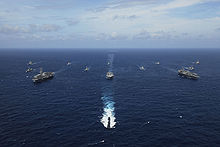 Naval ships from five nations in formation during Malabar 2007, the largest war-game hosted by India.[126]
Naval ships from five nations in formation during Malabar 2007, the largest war-game hosted by India.[126]
India often conducts naval exercises with other friendly countries designed to increase naval interoperability and also to strengthen cooperative security relationship. Some such exercises take place annually like the Varuna with the French Navy, Konkan with the Royal Navy, Indra with Russian Navy, Malabar with the U.S. Navy, Simbex[127] with the Republic of Singapore Navy and IBSAMAR[128] with the Brazil and South African navies.[129] The Indian Navy also conducted exercise with the People's Liberation Army Navy in 2003 and will send ships to the South China Sea to participate in the fleet review.[130] In 2007, the TROPEX (Theatre-level Readiness Operational Exercises) was held during which Indian Navy experimented the doctrine of influencing a land and air battle to support the Indian Army and the Indian Air Force.[131] Apart from the Indian Ocean, India has steadily gained influence in the Pacific Ocean. In 2007, Indian Navy conducted naval exercise with Japan Maritime Self-Defense Force and U.S Navy in the Pacific[132] and also signed an agreement with Japan in October 2008 for joint naval patrolling in the Asia-Pacific region.[133]
India has also held naval exercise with Vietnam,[134] Philippines and New Zealand.[135] In 2007, India and South Korea decided to conduct annual naval exercise[136] and India participated in the South Korean international fleet review.[137] In addition, Indian Navy will also be increasing naval cooperation with other allies, particularly with Germany[138] and Arab states of the Persian Gulf including Kuwait, Oman,[139] Bahrain and Saudi Arabia.[140][141] India held the first Indian Ocean Naval Symposium (IONS)[142] with an objective to provide a forum for all the littoral nations of the Indian Ocean to cooperate on mutually agreed areas for better security in the region.[143] The Indian Navy is increasingly used in international diplomacy.[144] Since 2000, the Indian naval ships have made port calls in Israel, Turkey, Egypt, Libya, Greece, Oman, Thailand, Indonesia, Australia, New Zealand, Tonga, South Africa,[145] Kenya,[146] Qatar, Oman, United Arab Emirates, Bahrain, Kuwait[147] and other countries in 2005–2007.
The first Atlantic Ocean deployment of the Indian Navy happened in 2009. During this deployment, the Indian Naval fleet will conduct exercise with the French, German, Russian and British Navies.[148]
Tropex 2010 is currently underway with the Western and Eastern fleets taking part along with elements from the airforce.[149] In 2010, Indian naval warships were deployed in the Asia pacific region, and conducted courtesy calls at friendly ports.[150]
Recently,Indian Navy carried out a Joint Naval exercise with Sri Lanka Navy codenamed SLINEX-II from 19th to 24th September'11.The exercise was aimed at increasing the capabilities of the two nations in carrying out anti-pirate operations and exchanging professional knowledge.[151]
Exploration
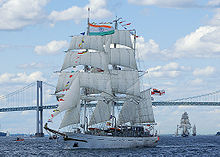 INS Tarangini is the only sail training ship in the Indian Navy and is an icon of India's rich maritime history.
INS Tarangini is the only sail training ship in the Indian Navy and is an icon of India's rich maritime history.
The Indian Navy regularly conducts adventure expeditions. The sailing ship and training vessel INS Tarangini began circumnavigating the world on 23 January 2003, intending to foster good relations with various other nations; she returned to India in May of the following year after visiting 36 ports in 18 nations.[152] INS Tarangini returned to port, after a ten month long overseas voyage named Lokayan 07.[153] Lt. Cdr. M.S. Kohli led the Indian Navy’s first successful expedition to Mount Everest in 1965; the Navy’s ensign was again flown atop Everest on 19 May 2004 by a similar expedition. Another Navy team also successfully scaled Everest from the north face, the technically more challenging route.[154] The expedition was led by Cdr Satyabrata Dam, belonging to the elite submarine arm. Cdr. Dam is a mountaineer of international repute and has climbed many mountains including the Patagonias, the Alps among others. This team's record is unmatched by any other navy. The Navy was also the first to send a submariner to summit Everest.[155]
An Indian Navy team comprising 11 members successfully completed an expedition to the Arctic pole. To prepare, they first travelled to Iceland, where they attempted to summit a peak.[156] The team next flew to eastern Greenland; in the Kulusuk and Angmassalik areas, they used Inuit boats to navigate the region’s ice-choked fjords. They crossed northward across the Arctic Circle, reaching seventy degrees North on skis. The team scaled an unnamed peak of height 11,000 feet (3,400 m) and named it ‘’Indian Peak’’.[157]
The Indian Naval ensign first flew in Antarctica in 1981.[158] The Indian Navy succeeded in Mission Dakshin Dhruv 2006 by traversing to the South Pole on skis. With this historic expedition, they have set the record for being the first military team to have successfully completed a ski traverse to the Geographic South Pole.[159] Also, three of the ten member team – the expedition leader – Cdr. Satyabrata Dam, leading medical assistants Rakesh Kumar and Vikas Kumar are now amongst the few people in the world to have visited the two poles and summited Mt. Everest.[160][161] Indian Navy became the first organisation to reach the poles and Mt.Everest.[162] Cdr. Dilip Donde completed the first solo circumnavigation by an Indian citizen on 22 May, 2010.[163][164]
Ongoing expansion
In 2004, India bought the Russian aircraft carrier, Admiral Gorshkov for the equivalent of US$1.5 billion. It will cost an additional US$1.5 billion to refit, and is expected to join the Indian Navy in 2012 as INS Vikramaditya. A further US$700 million will be spent to purchase 12 single-seat MiG-29K and four dual-seat MiG-29KUB fighters, six Kamov-31 attack and reconnaissance anti-submarine helicopters; also included are training facilities for pilots and technical staff, delivery of simulators and spare parts, and establishment and maintenance of Indian Navy facilities. Upgrades include removing missiles from the carrier foredeck to make way for a 14.3-degree ski-jump.[166] The Mig-29's will be delivered to the Indian Navy in 2009.[167]
In April 2007, India began construction of a 40,000 tonne Vikrant class aircraft carrier at a cost of US$800 million and scheduled to operate 30 aircraft, including Naval LCA,[168] MiG-29K, and Sea Harrier combat aircraft, as well as HAL Dhruv, Ka-31, and Sea King Mk.42 helicopters. Four turbine engines will power the ship. The carrier is being constructed by state-run Cochin Shipyard Limited.[169] and will be commissioned by 2012–13. The Indian Minister of State for Defence, Pallam Raju, went on record in September 2006 stating that the aircraft carrier is likely to be commissioned by 2011.[170] There are plans to build more aircraft carriers domestically.[171]
The Indian Navy is currently undergoing rapid expansion and modernisation.[172] Yantar, a plant in Kaliningrad, Russia, was awarded a US$1.56 billion contract to build three additional 1135.6 frigates. The increased price is due to more sophisticated armaments such as BrahMos cruise missiles. The Navy has government approval for an additional eight warships.
The Indian Navy has signed a deal with Boeing to supply twelve P-8 Poseidon Anti Submarine Warfare/Maritime Surveillance Aircraft. The first aircraft will be delivered 4 years after the signing of the contract, that is 2012.[173] Also there are plans to induct four AEW&C aircraft that will be based on super carriers.[174]
Future prospects
India is expected to spend about US$40 billion on military modernisation from 2008 to 2013.[175] A major chunk of those purchases were made for the Indian Navy. Design of a third 65,000 ton aircraft carrier called Indigenous Aircraft Carrier II (IAC-II)is ongoing and will be inducted into the Navy by 2017.[176] Order has been placed for seven Project 17A class frigates.[177] India is currently focusing on expanding its submarine fleet. Also newer technology like the Unmanned Underwater Vehicle (UUV) is being developed for the Indian Navy.[178][179]
After ordering six Scorpene submarines as part of Project 75, Indian Navy is now on the look out for six next-generation submarines in a project worth over
 50,000 crore (US$10.1 billion).[180] These six diesel-electric submarines built in India under Project-75I, will be equipped with air-independent propulsion boosting their operational capabilities and will have high degree of stealth, land-attack capability and ability to incorporate futuristic technologies. While according to the Defence Acquisition Council (DAC), three of the six submarines will be constructed at the Mazagon Dock Ltd (MDL) in Mumbai and one at Hindustan Shipyard Ltd (HSL) in Visakhapatnam, the two remaining submarines will either be imported or constructed at a private shipyard in India. RFI has been issued to Rosoboronexport, French (Armaris), Howaldtswerke-Deutsche Werft and other firms, two rounds of discussions have already taken place.
50,000 crore (US$10.1 billion).[180] These six diesel-electric submarines built in India under Project-75I, will be equipped with air-independent propulsion boosting their operational capabilities and will have high degree of stealth, land-attack capability and ability to incorporate futuristic technologies. While according to the Defence Acquisition Council (DAC), three of the six submarines will be constructed at the Mazagon Dock Ltd (MDL) in Mumbai and one at Hindustan Shipyard Ltd (HSL) in Visakhapatnam, the two remaining submarines will either be imported or constructed at a private shipyard in India. RFI has been issued to Rosoboronexport, French (Armaris), Howaldtswerke-Deutsche Werft and other firms, two rounds of discussions have already taken place.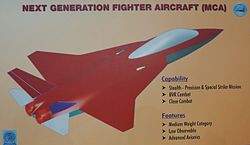 Indian Navy has shown interest in the Air Force's Advanced Medium Combat Aircraft
Indian Navy has shown interest in the Air Force's Advanced Medium Combat Aircraft
The RFP (request for proposal) for six MRMR aircraft with anti-submarine warfare (ASW) capabilities was issued on 11 July 2008 to Italian Alenia Aeronautica's ATR-72-500MP aircraft, Brazilian Embraer P-99 , French Dassault's Falcon 900DX and Russian Antonov-72P. The contract is expected to be signed in 2011 and deliveries to begin by 2012/2013. The contract is estimated to cost
 1,600 crore (US$324.5 million). The Navy is also planning to induct more UAVs. The India-Israel joint venture to convert the Chetak helicopters into unmanned UAV's that can operate from ships is progressing steadily. All these will be linked with space-based reconnaissance systems.[181] On 13 January 2009, India has issued a request for proposals (RFPs) for six Medium Range Maritime Reconnaissance (MRMR) aircraft. The new aircraft, which will replace the ageing fleet of 10 Islander aircraft in service, are to be equipped with an Airborne Early Warning system. The Indian Coast Guard has an additional requirement for six MRMRs without an Airborne Early Warning system. The MRMR is required to have a range of 500 nautical miles (930 km) and an endurance of 6 hours. Aircraft competing for the order include a variant of Boeing's P-8I, and possibly the turboprop ATR-72MP, EADS C-295, Dassault's Falcon 900MPA and Embraer P-99A platforms. For the Coast Guard RFP, contenders could be the ATR-42MP, C-295 or CN-235MP.
1,600 crore (US$324.5 million). The Navy is also planning to induct more UAVs. The India-Israel joint venture to convert the Chetak helicopters into unmanned UAV's that can operate from ships is progressing steadily. All these will be linked with space-based reconnaissance systems.[181] On 13 January 2009, India has issued a request for proposals (RFPs) for six Medium Range Maritime Reconnaissance (MRMR) aircraft. The new aircraft, which will replace the ageing fleet of 10 Islander aircraft in service, are to be equipped with an Airborne Early Warning system. The Indian Coast Guard has an additional requirement for six MRMRs without an Airborne Early Warning system. The MRMR is required to have a range of 500 nautical miles (930 km) and an endurance of 6 hours. Aircraft competing for the order include a variant of Boeing's P-8I, and possibly the turboprop ATR-72MP, EADS C-295, Dassault's Falcon 900MPA and Embraer P-99A platforms. For the Coast Guard RFP, contenders could be the ATR-42MP, C-295 or CN-235MP.In August 2009, the U.S. Navy and Northrop Grumman briefed the Indian Navy on the E-2D Advanced Hawkeye. This covered potential use of this platform to satisfy its current shore-based and future carrier-based Airborne Early Warning and Control (AEW&C) requirements. The Indian Navy reportedly expressed interest in acquiring up to six Hawkeyes.[182][183]
Indian Navy has issued a tender for procurement of 16 advanced, multi-role naval helicopters to AgustaWestland, EADS and Sikorsky. The order is likely to be expanded to 60 helicopters. The helicopters will be equipped with anti-ship and anti-submarine warfare equipment including cruise missiles and torpedoes, and also be capable of being refuelled in flight. The type will operate from both naval vessels and land bases.[184]
Global bids has been floated to acquire eight mine countermeasure vessels (MCMVs), to replace the twelve Pondicherry class ocean minesweepers in service. France's DCN International, Fincantieri of Italy, Izar of Spain, Kangnam Shipbuilding Co. of South Korea and Northrop Grumman of the U.S have been invited to participate in the bidding process. Six of the craft will be produced at Goa shipyard under transfer of technology.[185]
With the recent and ongoing upgrades and inductions, independent analysts expect that the Indian Navy may soon become a blue-water navy.[186] India's navy is already the most powerful in the region,[187] and with further upgrades in the future, aims to control the Indian Ocean Region, from the coast of East Africa to Australia.[188] India is also the only Asian navy to regularly operate aircraft carriers.[189] The aim is to have a total of three Aircraft carriers resulting in two fully operational Carrier battle groups and an additional Aircraft carrier eventually in refit making India an operating Blue-water navy.[190]
The ambitious long term plan that was recently revealed shows a road-map to blue water navy with six aircraft carriers.[191]
See also
- Indian Naval Academy
- Indian Naval Air Arm
- Naval ranks and insignia of India
- Project Seabird
- Indian Ancient Maritime History
- Kanhoji Angre – Notable Maratha Admiral after whom INS Angre – the western naval command – is named.
- Kunjali Marakkar – Navy Chief of the Zamorin after whom INS Kunjali – the western naval command – is named
- Chempil Arayan
- Middle Ground Coastal Battery
- Indian Coast Guard
References
- Notes
- ^ Honorary/War time rank. No officer held this rank in the Indian Navy.
- Citations
- ^ http://csis.org/files/media/csis/pubs/060626_asia_balance_powers.pdf
- ^ a b Global Security article on the Indian Navy
- ^ Fast Interceptor boats for Sagar Prahari Bal
- ^ The first fleet tanker for the Indian Navy delibered in Mumbay.
- ^ The Gorshkov deal
- ^ Scott, Dr. David (Winter 2007–08). (PDF)Journal of Military and Strategic Studies, (Brunel University) 10 (2). Archived from the original on May 28, 2008. http://web.archive.org/web/20080528002213/http://www.jmss.org/2008/winter/articles/scott.pdf.
- ^ "India's 12 Steps to a World-Class Navy". http://www.indian-military.org/indian-military-reports/indian-navy/87-indias-12-steps-to-a-world-class-navy.html.[dead link]
- ^ "Navy expands footprint in Indian Ocean". Chennai, India: The Hindu. 20 May 2010. http://beta.thehindu.com/news/national/article433950.ece.
- ^ Dr. Thomas P.M. Barnett (2001). "India's 12 Steps To A World Class Navy". Bharat-Rakshak. http://www.bharat-rakshak.com/NAVY/History/2000s/Barnett.html.
- ^ "Shaping India's maritime strategy – opportunities and challenges". http://indiannavy.nic.in/cns_add2.htm.
- ^ "India prepared for global security role: Antony". http://www.zeenews.com/articles.asp?rep=2&aid=374782&sid=NAT.
- ^ Interesting facts about India
- ^ Maritime trade with the west
- ^ Indus Valley Civilization
- ^ Economics of the Indus valley civilization
- ^ How to Build a Dock
- ^ Indian seabed hides ancient remains
- ^ History of the Indian Navy
- ^ Stamps issued in 2001
- ^ Inmed
- ^ "Indian Navy". http://www.indiannavy.nic.in/goa.htm.
- ^ India's Quest for Security: defence policies, 1947–1965 By Lorne John Kavic, , 1967, University of California Press, pp 190
- ^ Baluchis, Beijing, and Pakistan’s Gwadar Port – Henry L. Stimson Center
- ^ The Resurgence of Baluch nationalism by Frédéric Grare – Carnegie Endowment for International Peace
- ^ Gopal, B. Madhu (December 2, 2006). "Metro Plus Visakhapatnam : Remembering our war heroes". The Hindu (Chennai, India). http://www.hindu.com/mp/2006/12/02/stories/2006120202090100.htm. Retrieved 11 June 2010.
- ^ "'Does the US want war with India?'". January 22, 2007. http://www.rediff.com/news/2007/jan/22inter.htm. Retrieved 11 June 2010.
- ^ Vice-Admiral (Retd) G M Hiranandani. Transition to Triumph: Indian Navy 1965 – 1975. ISBN 1897829728.
- ^ Pakistan Navy
- ^ "Maritime Awareness and Pakistan Navy". Defence Notes by Commander (Retd) Muhammad Azam Khan. http://www.defencejournal.com/2000/mar/maritime.htm. Retrieved 16 May 2005.
- ^ "Items in India/Pakistan/Bangladesh - Report of the high level consultants mission to Bangladesh". United Nations. http://archives-trim.un.org/webdrawer/rec/423368/view/Items-in-IndiaPakistanBangladesh%20-%20general%20-%20report%20of%20the%20high%20level%20consultants%20mission%20to%20Bangladesh%20MarchApril%201972.pdf. Retrieved 26 July 2011.
- ^ US intervention in 1971 war
- ^ Bangladesh: Out of War, a Nation Is Born Dec. 20, 1971 Time
- ^ The Bangladesh war Britannica online
- ^ The courage to say no!
- ^ [1][dead link]
- ^ "Operation Cactus – Indian Navy". Armedforces.nic.in. 1988-11-03. http://armedforces.nic.in/navy/cactus.htm. Retrieved 2010-07-16.
- ^ 'India's national interest had been made coterminous with maritime security'
- ^ John Pike. "1999 Kargil Conflict". Globalsecurity.org. http://www.globalsecurity.org/military/world/war/kargil-99.htm. Retrieved 2010-07-16.
- ^ The Indian Navy celebrates its silent Kargil victory
- ^ Ministry of Defence Report
- ^ "Indian Navy's Vision". Indian Navy. http://indiannavy.nic.in/vision.pdf. Retrieved 2011-08-03.
- ^ "BHARAT RAKSHAK MONITOR – Volume 6(1) Jul–Aug 2003". Bharat-rakshak.com. http://www.bharat-rakshak.com/MONITOR/ISSUE6-1/Sakhuja.html. Retrieved 2010-07-16.
- ^ President Discusses Strong U.S.-India Partnership in New Delhi, India 3 March 2006, The White House
- ^ a b Tsunami diplomacy improves India's global image
- ^ Indian Naval Diplomacy: Post Tsunami
- ^ India is projecting its military power
- ^ "National : INS Jalashwa joins Eastern Fleet". Chennai, India: The Hindu. 2007-09-14. http://www.hindu.com/2007/09/14/stories/2007091454111600.htm. Retrieved 2010-07-16.
- ^ INS Jalashwa joins Eastern Fleet
- ^ Operation Sukoon
- ^ Operation Sukoon @ official website
- ^ Indian Navy Doctors Serve on U.S. Navy Hospital Ship Mercy’s Aid Mission in South and Southeast Asia
- ^ India sends rice for Bangladesh storm victims
- ^ "India sends food for Nargis survivors". Business-standard.com. 2008-05-12. http://www.business-standard.com/india/storypage.php?tp=on&autono=37324. Retrieved 2010-07-16.
- ^ India's assistance to Myanmar must reflect its regional role
- ^ Navy, Coast Guard nab pirates, rescue hijacked merchant vessel off Goa coast
- ^ How sea piracy is hurting India
- ^ "India 'to step up piracy battle'". BBC News. 21 November 2008. http://news.bbc.co.uk/2/hi/south_asia/7741287.stm. Retrieved 5 May 2010.
- ^ Indian Navy destroys pirate ship in Gulf of Aden
- ^ Apprehension of Pirate Vessel
- ^ INS Godavari foils piracy attempt
- ^ Over Thousand Ships Safely Escorted Across Gulf of Aden by Indian Navy
- ^ "India 'sinks Somali pirate ship'". BBC News. 19 November 2008. http://news.bbc.co.uk/2/hi/south_asia/7736885.stm. Retrieved 5 May 2010.
- ^ Navy responds to SOS from Seychelles
- ^ Indian navy foils pirate attack in Gulf of Aden.
- ^ Indian Navy ship foils piracy bid near Seychelles, nine arrested
- ^ http://www.csmonitor.com/World/Asia-South-Central/2011/0207/India-pushes-back-on-Somali-pirates-new-mother-ship-offensive
- ^ http://www.marinebuzz.com/2011/01/30/pirate-mother-ship-prantalay-sinks-off-lakshadweep-during-anti-piracy-operations-by-india/
- ^ http://www.dnaindia.com/india/report_navy-intercepts-pirate-ship-13-crew-rescued-61-brigands-held_1519685
- ^ http://www.msnbc.msn.com/id/42066300
- ^ http://www.dailybreeze.com/latestnews/ci_17611248
- ^ Vice Admiral Nirmal Verma takes over as Navy chief The Times of India, Aug 31, 2009
- ^ Commanding the ocean
- ^ Analysis - India, China navies square off in nearby seas and beyond
- ^ Malacca Straits security: role seen for Indian Navy
- ^ India, Australia sign defence accord
- ^ Project Seabird
- ^ Naval Chief: PM to commission Ezhimala Academy
- ^ India navy drops another anchor
- ^ Navy to set up second base in Vizag
- ^ Eying China, India Plans New East Coast Navy Bases – DefenseNews (8 December 2010)
- ^ Indian Navy to lease station in Madagascar
- ^ India activates first listening post on foreign soil: radars in Madagascar
- ^ India, Mozambique sign maritime defense agreement
- ^ India set to drop anchor off China
- ^ Navy's Marine Commandos steal the show
- ^ MARCOS (Marine Commandos)
- ^ Russia, India to sign addendum on Admiral Gorshkov deal.India is working on big cariers
- ^ First Scorpene submarine from Mazagaon to roll out in 2015
- ^ India plans to buy 6 new subs, says Navy chief
- ^ http://www.indian-military.org/news-archives/indian-navy-news/1402-india-to-issue-11-bn-tender-for-six-more-submarines.html
- ^ Akula class submarine
- ^ India to get Russian nuclear submarine on lease in fall
- ^ The secret nuke sub deal
- ^ Indian nuclear submarine", India Today, August 2007 edition
- ^ Pandit, Rajat (July 17, 2009). "India set to launch nuclear-powered submarine". Indiatimes (New Delhi). http://timesofindia.indiatimes.com/NEWS-India-India-set-to-launch-nuclear-powered-submarine/articleshow/4787167.cms. Retrieved 11 June 2010.
- ^ "PIB press release" (Press release). PIB. July 26, 2009. http://pib.nic.in/release/phsmall.asp?phid=23704. Retrieved 11 June 2010.
- ^ Navy creating a new base for nuke submarines
- ^ Russia confirms delivery of Admiral Gorshkov in 2012
- ^ "PM to launch indigenous nuke submarine by month-end – National News – News – MSN India". News.in.msn.com. http://news.in.msn.com/national/article.aspx?cp-documentid=3097464. Retrieved 2010-07-16.
- ^ The secret undersea weapon, India Today[dead link]
- ^ Unnithan, Sandeep (July 23, 2009). "Deep impact". India Today. http://indiatoday.intoday.in/index.php?option=com_content&task=view&id=53210&Itemid=1&issueid=116§ionid=40&latn=2&limit=1&limitstart=2.
- ^ Indian military aviation OrBat
- ^ India inks largest-ever defence deal with US
- ^ India, US defence deal set to get bigger
- ^ "Indian Navy chief to inspect MiG-29K assembly in Russia". RIA Novosti (Moscow). 2008-03-13. http://en.rian.ru/world/20080313/101241741.html. Retrieved 11 June 2010.
- ^ "RAC MiG flies first MiG-29K for Indian Navy". Frontier India. March 22, 2008. http://frontierindia.net/rac-mig-flies-first-mig-29k-for-indian-navy. Retrieved 11 June 2010.
- ^ "Russia delivers 4 MiG-29 fighters to India". RIA Novosti (Bangalore (India)). 12/02/2009. http://en.rian.ru/world/20090212/120111325.html. Retrieved 11 June 2010.
- ^ MiG-29 Fulcrum High-Performance Combat Aircraft, Russia airforce-technology.com
- ^ "India may bag more Mig-29K fighters". September 25, 2008. http://www.rediff.com/cms/print.jsp?docpath=//news/2008/sep/25mig.htm. Retrieved 11 June 2010.
- ^ Indian Navy fastens its seatbelt for Light Combat Aircraft Tejas
- ^ Sepecat/HALJaguar
- ^ Image of IAF maritime Jaguar
- ^ Indian Air Force's Su-30MKI ready for maritime role
- ^ India opts for US Harpoon missiles
- ^ Israel, India to Cooperate on $350M Long-Range Barak SAM Project
- ^ Brahmos naval version tested successfully
- ^ Sangraha electronic warfare system
- ^ Navy building high-speed data network
- ^ Change but Continuity: The Indian Navy Marches Ahead
- ^ Information technology and Indian Navy
- ^ President's fleet review
- ^ Bridges of friendship gallery
- ^ Bridges of Friendship
- ^ Indian Navy Displays its Blue-Water Capabilities
- ^ Milan exercise concludes with passage exercise
- ^ Largest Navy War Game
- ^ Simbex-2009
- ^ India-Brazil-South Africa ‘Tango’ at Sea
- ^ Indian warships to exercise with Brazil, S Africa
- ^ India to take part in China's International Fleet Review
- ^ "India eNews – Indian Navy validates new maritime warfare doctrine". http://www.indiaenews.com/india/20070226/41056.htm.
- ^ Indian Navy holds joint drills with top naval powers
- ^ Eye on China, India and Japan ink security pact
- ^ Two Indian naval ships dock in Sai Gon Port for 5-day visit.
- ^ Indian Navy engages US and Russia away from Home
- ^ India, S Korea to hold joint naval exercise
- ^ "Indian Navy to participate in South Korean international fleet review". Thaindian.com. 2008-08-20. http://www.thaindian.com/newsportal/uncategorized/indian-navy-to-participate-in-south-korean-international-fleet-review_10086625.html. Retrieved 2010-07-16.
- ^ Indo-German naval exercises to begin today
- ^ Abu Dhabi:Indian naval ships attract visitors
- ^ Naval flotilla to hold exercises with Persian Gulf states
- ^ India ready for naval exercises with GCC countries
- ^ IONS-Official website
- ^ PM calls on Indian Ocean navies to pool resources
- ^ Indian navy's role in international diplomacy increasing
- ^ Realising the Indian Dream
- ^ Indian ship bids farewell to Kenya
- ^ Indian naval ships coming on courtesy tour
- ^ Navy war games with French, British in Atlantic next month
- ^ Indian Navy begins TROPEX 2010
- ^ India Sets Sail for Leadership
- ^ [2]
- ^ INS Tarangini
- ^ A ship sails tall and proud
- ^ Indian Navy on top of the world
- ^ I Indian Navy summits Everest
- ^ Indian Navy Team in Iceland
- ^ Chilling out!
- ^ Indian Navy timeline
- ^ Navy team becomes first military unit to ski to South Pole
- ^ Indian Navy Mission Dakshin Dhruv 2006–07
- ^ The Indian Navy team all set to scale Mount Everest following the Tibet route
- ^ Indian Navy North pole team creates record
- ^ http://www.sail-world.com/NZ/Dilip-Donde-completes-first-solo-circumnavigation-for-India/69842
- ^ http://en.mercopress.com/2010/01/26/indian-commander-celebrates-60th-republic-day-in-the-falklands
- ^ Upgraded ASW aircraft Tu-142ME delivered to Indian Navy
- ^ A report on India's purchase of Admiral Gorshkov
- ^ Indian carrierborne MiG handover inches closer
- ^ Naval Version of Light Combat Aircraft Rolls out a Defining and Memorable Occasion for the Nation – Antony
- ^ India's construction of aircraft carrier.
- ^ IAC construction
- ^ *India to have ‘3-carrier Navy’
- ^ *Indian Navy's 15-Year Modernization Plan Progresses
- ^ Rajat Pandit, TNN, Jan 5, 2009, 12.55am IST (2009-01-05). "India inks largest-ever defence deal with US – India – The Times of India". Timesofindia.indiatimes.com. http://timesofindia.indiatimes.com/India_inks_largest-ever_defence_deal_with_US/articleshow/3934357.cms. Retrieved 2010-07-16.
- ^ Indian Navy planning to procure 4 planes for airborne surveillance
- ^ India is projecting its military power-Page 2>
- ^ Indian Navy to get third aircraft carrier by 2017
- ^ Navy seals 45,000-cr deal: seven warships
- ^ DRDO developing unmanned underwater vehicle
- ^ Unmanned defence systems come of age
- ^ Project-75I Becomes India’s New Record Defence Programme
- ^ Indian Navy Mulls Northrop Advanced Hawkeye
- ^ Indian Navy Pursues Fixed-Wing Carrier AEW
- ^ Naval helicopter request for proposals expected around mid-2009
- ^ India Seeks 8 Mine Countermeasure Vessels
- ^ India Pursuing Blue Water Navy, Ballistic Missile Sub
- ^ Background Note: India Bureau of South and Central Asian Affairs, October 2006, U.S. State Department
- ^ March 12, 2007 'THE MIDEAST MAY SOON FEEL INDIA’S GROWING POWER'
- ^ Beijing still quiet on US-India deal By Yuan Jing-dong 16 March 2006 Taipei Times
- ^ Pandit, Rajat (Jan 8, 2007). "Carrier battle groups will add muscle to Navy power". Indiatimes (On Board INS Viraat (Arabian Sea)). http://timesofindia.indiatimes.com/articleshow/1086252.cms. Retrieved 11 June 2010.
- ^ Raghuvanshi, Vivek (17 Aug 2009). "Indian Aircraft Carrier Back in Service in a Month". Defense News. http://www.defensenews.com/story.php?i=4238801&c=ASI&s=SEA. Retrieved 11 June 2010.
- Bibliography
- Blue print to blue water 1951–65 Rear Admiral (Retd) Satyindra Singh AVSM
- The Transition to Triumph and Transition to Eminence written by Vice Admiral(Retd) GM Hiranandani PVSM, AVSM, NM, PhD
- The Indian end of the telescope: India and its navy, Naval War College Review, Spring, 2002 by Gulab Hiranandani.
- India in the Indian Ocean, Naval War College Review, Spring, 2006 by Donald L.Berlin
- Rahul Roy-Chaudhury (2000). India’s Maritime Security. India: Institute for Defence Studies and Analyses. ISBN 81-86019-29-4.
- Indian Navy's Southern Naval Command (2005). A Shared Destiny: The Indian Navy and the City of Kochi. Kochi: Headquarters of Southern Naval Command. OCLC 70335840.
- Goldrick, James (1997). No Easy Answers: The Development of the Navies of India, Pakistan, Bangladesh, and Sri Lanka, 1945–1996. Lancer Publishers. ISBN 1-897829-02-7.
- Vice Admiral Mihir K. Roy (1995). War in the Indian Ocean. New Delhi: Lancer Publishers. ISBN 1-897829-11-6.
- Vice Admiral S. H. Sarma (2001). My Years At Sea. New Delhi: Lancer Publishers & Distributors. ISBN 81-7062-121-6.
External links
Ship classes of the Indian NavyAircraft Carriers INS Viraat · Vikramaditya* · Vikrant*

Destroyers Frigates Corvettes Veer (Tarantul) · Abhay (Pauk) · Khukri · Kora · Kamorta*
Submarines Kalvari · Sindhughosh · Shishumar · Scorpène*
Nuclear Submarine Amphibious warfare ships Kumbhir · Magar · Shardul · INS Jalashwa
Patrol craft Seaward · Sukanya · Super Dvora Mk.II · Trinkat · Bangaram · Car Nicobar · Saryu* · Minesweeper
Replenishment ship Training
INS Tir- - Under Construction/Procurement · ** - SSBN
Ships of the Indian Navy
 Military of India Portal ·
Military of India Portal ·  Category (Army · Navy · Air Force · Coast Guard)
Category (Army · Navy · Air Force · Coast Guard)Branches Wars and
conflictsIndo-Pakistani wars of 1947 / 1965 / 1971 · Operation Polo · Operation Vijay · Sino-Indian War · Chola incident · Siachen conflict · Blue Star · Woodrose · 1987 Sino-Indian skirmish · Indian intervention in the Sri Lankan Civil War · Operation Cactus · Kargil War · Kashmir insurgency · 2001 Indian–Bangladeshi border conflict · Operation Parakram · Piracy in SomaliaCategories:- Military of India
- Indian Navy
Wikimedia Foundation. 2010.

